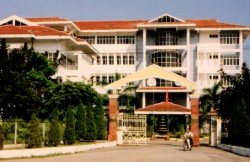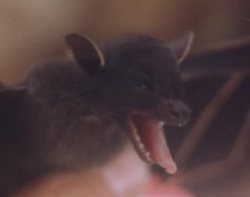|
CONTRIBUTION OF THE RUSSIAN-VIETNAMESE
TROPICAL CENTRE TO THE STUDY OF BATS (CHIROPTERA) OF VIETNAM
A. V. Borissenko and S. V. Kruskop
Zoological Museum of Moscow University
INTRODUCTION
The order of bats (Chiroptera) is the second largest order of mammals
containig ca. 1000 species and having nearly worldwide distribution.
The bulk of the diversity of bats is confined to the tropics, where
they play a tremendous role in ecological communities, generally
as consumers of insect and plant biomass, as pollinators and an
important food resource for a variety of predators. This role, however,
is apparently underestimated, due to the lack of knowledge on most
regional tropical bat faunas.
 Until
recently Vietnam remained one of the least studied areas of the
Indomalayan Region in terms of chiropteran diversity. Recent extensive
surveys of a number of protected areas undertaken by a number of
researchers from different countries have yielded a number of interesting
zoogeographical findings and even taxonomical innovations. Nevertheless,
much of our knowledge of Vietnamese bats is limited to faunal lists
compiled for relatively small territories. Until
recently Vietnam remained one of the least studied areas of the
Indomalayan Region in terms of chiropteran diversity. Recent extensive
surveys of a number of protected areas undertaken by a number of
researchers from different countries have yielded a number of interesting
zoogeographical findings and even taxonomical innovations. Nevertheless,
much of our knowledge of Vietnamese bats is limited to faunal lists
compiled for relatively small territories.
The aim of the present report is to outline the contribution of
the Tropical Centre to the studies of bats of Vietnam.
METHODS
Before 1997 during the expeditions of the Tropical Centre no specific
bat surveys were undertaken. However, material on bats was collected
as a by-product of mammalogical and ornithological surveys and subsequently
deposited in the Zoological Museum of Moscow University (Moscow,
Russia). Most bats were collected by German V. Kuznetsov and Mikhail
V. Kalyakin, either captured in bird mist nets, or taken inside
day roosts. The absence of chiropterological surveys as a separate
goal resulted in relatively poor  representation
of the diversity of bats in each of the sites. Most of the specimens
collected represented common and abundant species, however, a number
of new zoogeographical records were made, e. g., the Himalayan fruit
bat Sphaerias blanfordi was found in Tam Dao Prov. by G.
Kuznetsov. representation
of the diversity of bats in each of the sites. Most of the specimens
collected represented common and abundant species, however, a number
of new zoogeographical records were made, e. g., the Himalayan fruit
bat Sphaerias blanfordi was found in Tam Dao Prov. by G.
Kuznetsov.
During the last two expeditions (Vu Quang 1997 and Phong Nha 1999)
particular attention was paid to surveying bats. As a result the
bats were represented much better, which enabled to compile more
or less comprehensive faunal lists of the studied areas. Additional
to the standard method of capturing bats in mist nets, ultrasound
detectors were employed, and the original method of capturing bats
with mobile traps (Borissenko, 1999) was extensively used, which
enabled to collect data on behavioral patterns of certain bat species.
SPECIES LISTS AND FAUNISTIC RECORDS
During the expeditions of the Tropical Centre bats were collected
in 16 localities, mostly confined to the north, north-central and
southern parts of the country. For reasons mentioned above the diversity
of sampled bat taxa is uneven, the most diverse samples being from
Vu Quang and Ke Bang.
The list of bat species collected in Vietnam during the expeditions
of the Tropical Centre contains 41 species, of the ca. 90 species
hitherto reported from this country. Among them are four species
which have not been previously listed in available publications
and unpublished reports. This includes a small mouse-eared bat representing
a new species - Myotis annamiticus
(Kruskop, Tsytsulina, 2001).
The complete taxonomic list of bat species collected in Vietnam
during the expeditions of the Tropical Centre is not yet published.
However, annotated lists are available for the last two expeditions
(Kruskop, 2000; Kuznetsov et al., 2001).
OTHER STUDIES
Particular focus on bats during the last two expeditions of the
Tropical Centre enabled to start the accumulation of data on ecology
and natural history of bats during the surveys. These include an
eco-morphological assessment of the structure of the bat community
of Vu Quang (Borissenko et al., 2001), observations on cave dwelling
bats of Phong Nha (Kruskop, 2000), and studies on parasitic flies
of bats (Farafonova, Borissenko, 2001; Farafonova, Kruskop, in press).
Ecological assessments of the state of local bat communities are
of especial importance, as they are indicative of the state of the
eco-systems in general. Thus it is proposed that aside from the
necessary faunistic reconnaissance studies resulting in species
lists, extensive ecological monitoring of bats should be introduced
in surveyed areas. The should form a good basis for elaborating
site-specific conservation activities.
RECENT PUBLICATIONS ON BATS OF VIETNAM RELEVANT TO THE EXPEDITIONS
OF THE TROPICAL CENTRE
- Borissenko A. V., S. V. Kruskop, E. V. Dorokhina. 2001.
The bats (Chiroptera) of the Vu Quang Nature Reserve: community
structure and ecomorphological patterns. Pp. 190-215 in: Materials
of Zoological and Botanical Studies in Vu Quang Nature Reserve
(Ha Tinh Province, Vietnam). L. P. Korzun, M. V. Kalyakin, eds.
Joint Russian-Vietnamese Science and Technological Tropical Centre.
467 p. [In Russian with English summary].
- Farafonova G. V., A. V. Borissenko. 2001. Parasitic flies
(Diptera: Nycteribiidae, Streblidae) of Vietnamese bats. Pp. 383-391
in: Materials of Zoological and Botanical Studies in Vu Quang
Nature Reserve (Ha Tinh Province, Vietnam). L. P. Korzun, M. V.
Kalyakin, eds. Joint Russian-Vietnamese Science and Technological
Tropical Centre. 467 p. [In Russian with English summary].
- Farafonova G. V., S. V. Kruskop. 2001. Notes on the Nycteribiidae
(Diptera) of Viet Nam. - International Journal of Dipterological
Research, 12(1): 29-31.
- Kruskop S. V. 2000. New bat records from central Vietnam.
Plecotus et al., 3: 121-128. [In Russian with English summary].
- Kruskop S. V. 2000. The bats in caves of Ke Bamng limestone
area (central Vietnam). Plecotus et al., 3: 114-120. [In Russian
with English summary].
- Kruskop S. V., K. A. Tsytsulina. 2001. A new big-footed
bat Myotis annamiticus sp. nov. (Vespertilionidae, Chiroptera)
from Vietnam. Mammalia, 65(1): 63-72.
- Kuznetsov G. V., A. V. Borissenko, V. V. Rozhnov. 2001.
A synopsis of the mammal fauna of the Vu Quang Nature Reserve.
Pp. 161-189 in: Materials of Zoological and Botanical Studies
in Vu Quang Nature Reserve (Ha Tinh Province, Vietnam). L. P.
Korzun, M. V. Kalyakin, eds. Joint Russian-Vietnamese Science
and Technological Tropical Centre. 467 p. [In Russian with English
summary].
- Borissenko A. V., Kruskop S. V. 2003. Bats of Vietnam
and adjacent territories. An identification manual. Biodiversity
of Vietnam series, Ìoscow., GEOS, 203 pp.
|





